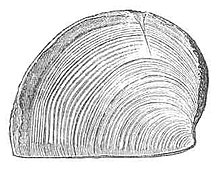Trigonellites: Difference between revisions
No edit summary |
No edit summary |
||
| Line 13: | Line 13: | ||
| familia = ''[[incertae sedis]]'' |
| familia = ''[[incertae sedis]]'' |
||
| genus = {{extinct}}'''''Trigonellites''''' |
| genus = {{extinct}}'''''Trigonellites''''' |
||
| genus_authority = Parkinson, 1811 |
| genus_authority = [[James Parkinson|Parkinson]], 1811 |
||
| type_species = {{extinct}}'''''Trigonellites latus''''' |
| type_species = {{extinct}}'''''Trigonellites latus''''' |
||
| type_species_authority = |
| type_species_authority = , 1811 |
||
| subdivision_ranks = Other species |
| subdivision_ranks = Other species |
||
| subdivision = |
| subdivision = |
||
Revision as of 14:42, 8 July 2020
This article, Trigonellites, has recently been created via the Articles for creation process. Please check to see if the reviewer has accidentally left this template after accepting the draft and take appropriate action as necessary.
Reviewer tools: Inform author |
T. latus redirects here. For the dinosaur, see Torosaurus.
| Trigonellites Temporal range: Late Jurassic, ~
| |
|---|---|

| |
| 1895 drawing of an aptychi of T. latus | |
| Scientific classification | |
| Kingdom: | |
| Phylum: | |
| Class: | |
| Subclass: | |
| Family: | |
| Genus: | †Trigonellites Parkinson, 1811
|
| Type species | |
| †Trigonellites latus , 1811
| |
| Other species | |
| |
Trigonellites is an extinct genus of Late Jurassic ammonite, known from three species, discovered in an outcrop of the Kimmeridge Clay Formation in Ely, England.[2] It was originally classified as a bivalve,[1] but it has since been classed as an ammonite species. Only two species once placed in the genus are still considered valid today: T. latus and T. curvirostris, with one dubious species, T. simplex, possibly being a species of Lyrodon.[1]
The genus name Trigonellites was originally proposed for some calcareous plates found in Cretaceous oolitic rocks , but these have since been declassed as indeterminate ammonites. The name has since been used to represent three species of Late Jurassic (c.156-151 Ma) ammonites.[1]
References
- ^ a b c d G. A. Goldfuss. 1863. Abbildungen und Beschreibungen der Petrefacten Deutschlands und der angrenzenden Länder. Divisio Quarta: Molluscorum acephalicorum reliquiae. Muschelthiere der Vorwelt. 1. Bivalvia. Petrefacta Germaniae 4(1):1-273 [A. Dunhill/B. Allen]
- ^ J. Prestwich. 1879. On the discovery of a species of Iguanodon in the Kimmeridge Clay near Oxford; and a notice of a very fossiliferous band of the Shotover Sands. Geological Magazine, new series, decade 2 6(5):193-195 [M. Carrano/M. Carrano]
This article, Trigonellites, has recently been created via the Articles for creation process. Please check to see if the reviewer has accidentally left this template after accepting the draft and take appropriate action as necessary.
Reviewer tools: Inform author |

